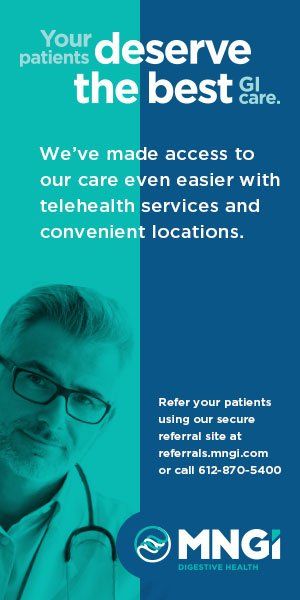Interview
Creating Positive Change
Sue Abderholden, MPH executive director, NAMI Minnesota
What are some of the biggest changes you have seen in how we approach mental health care?
When I first came to NAMI Minnesota 25 years ago, mental health treatment was not viewed as part of our health care system. There was limited coverage of treatment and services under Medicaid, Medicare and private insurance. It wasn’t unusual for a person to be allowed only a limited number of therapy visits. More intensive treatment was often funded through county dollars or grants. It wasn’t until the Mental Health Action Group formed and developed (and passed) recommendations that we had a list of treatment and services that would be funded under Medicaid. People no longer had to wait for county funds to become available.
There wasn’t a lot of awareness of the symptoms of mental illnesses. Over the years legislation has passed to require teachers, police and others to have training and education on mental illnesses and suicide prevention. When you see someone as experiencing symptoms instead of exhibiting behaviors, the way you interact with them changes dramatically – in a positive way.
Medicaid expansion was extremely beneficial for people with mental illness because they no longer had to wait to become certified as disabled by the Social Security Administration to be eligible for Medicaid. Especially for young adults who were experiencing their first serious symptoms of a mental illness, they could more easily access the treatment and services they needed, and our mental health system was able to decrease the amount of uncompensated care. More recently Medicare finally recognized marriage and family therapists to be seen as mental health professionals so their treatment could be paid for under Medicare.
Who have been some of the people who were inspirations in your career, and why?
It’s really been the people with mental illnesses and their families. It takes determination and courage when mental illnesses impact an individual and their family. I have seen people be incredibly resourceful, amazingly strong advocates, and ever clinging to hope.
One family had a son really struggling with schizophrenia. Even with treatment the symptoms never disappeared. He was in and out of hospitals. But they never gave up. And what was inspiring is that they looked at the barriers to his care not as stumbling blocks but as policies that should be changed. They testified several times before the legislature, and their elected officials knew them by name. And several of the policies were changed thanks to their sharing their story.
The people with mental illnesses who lead our support groups or share their stories through our In Our Own Voice program also inspire me. They all struggled with their mental illness at one time. And yet they take those stories and use them to help others, and to raise awareness. For people who are currently struggling, it gives them hope to see someone who struggled giving back to their community.
And then there were the Arc women, an advocacy group for people with developmental or intellectual disabilities. In the ‘80s these women who volunteered were incredibly knowledgeable about the legislative process and how to create change. Darlene, Betty, Bette, Sally – they all taught me so much. The best advice they gave me is that when I look ahead and see how much needs to be done, I need to look behind me and see how far we’ve come.
What are some of the most significant challenges involved with addressing mental health conditions?
There are really three challenges. One of the hardest challenges is when people experience anosognosia – where people don’t believe they have a mental illness. It is so difficult to get people the help they need in these situations, and families struggle with how to help them.
The second challenge is that we are really just beginning to fully understand the brain and be able to see it thanks to technology. There isn’t yet a blood test or imaging test to diagnose a mental illness, and it’s still difficult to know which medications will work the best. I am hopeful that diagnosis and treatment will be improved in the next few years.
The third challenge is we have not yet fully built our mental health system. The system isn’t broken, it wasn’t built. The institutions were not a system. President Eisenhower’s mental health commission laid out a framework that if it had been funded would have resulted in having a system. What’s frustrating is that we know what works – intensive first episode programs, assertive community treatment, supportive housing, mobile crisis management – we just don’t fund them.
One of our guiding principles is to empower our patients to be their own advocates.
What are some of the biggest societal misconceptions around mental health conditions?
One of the biggest misconceptions is that people with mental illnesses are violent. It’s unfortunate that such incidents that do occur are widely broadcast in the media. Most of the research shows that it’s a very small percentage. Even with mass shootings we know that there are many other complicating factors. The reason it’s important to dispel this myth is that it prevents people, especially younger adults, from seeking treatment early because they are afraid of how people will think of them.
The other misconception is related to employment. Many people with mental illnesses want to work, and evidence-based practice shows that work helps people in their recovery. The biggest problem is that few employers know what accommodations are needed in the workplace to address mental illnesses. We have seen greater interest since COVID because so many employees – especially those working in health care, have been struggling with their mental health during and after that period.
What are the best ways to change these misconceptions?
The greatest effect on changing attitudes comes from the sharing of people’s stories. It can take those with mental illnesses awhile to find the right medications and treatment and gain access to those community supports, but eventually many of them do so and they live full lives in the community.
Think of all the people who have come forward – from athletes, to actors, to elected officials, to everyday people. When we hear these stories we better understand the struggle people face but we also feel hope when we see them being better.
Identifying mental illnesses early absolutely yields the best outcomes. When clinics put out information about depression or anxiety – even psychosis – patients are more likely to discuss their symptoms and ask for help. It essentially signals to them that it’s OK to talk about their mental health with the physician.
It’s also important to recognize that treating mental illness is not just about taking medication. It’s therapy, nutrition, moving, mindfulness, learning coping skills and connecting to others. It’s also about the social determinants of health — whether people have housing, and so forth.
How can the stories of individuals be best used to affect the creation of public policy around mental health conditions?
Public policies are about people and how these policies affect people’s lives. People need to share their stories and help legislators understand how a bill will either help or hurt them. Over and over again throughout my career, I have seen the effectiveness of these stories. And I would add that many people testify in favor of bills that will no longer help them but will help the people coming behind them. In the 1980s mothers of teens testified in favor of special education going down to birth, as soon as a disability is identified, because they hadn’t had early access. An adult living with a mental illness shared how the evidence-based employment program (IPS) helped him get and keep a job because the job supports were provided alongside the mental health supports. A teen testified how important it was to allow 16-year-olds to consent to mental health treatment, especially when their parents didn’t understand mental illnesses. I could literally provide hundreds of examples – including MMA’s bringing patients to testify on the difficulties people experience with prior authorization or mid-year formulary changes.
Please share some of the most outstanding success stories you have seen whether involving individuals, policy development or both.
This past session we worked on ensuring that families are not referred to child protection when their children are in an ED and are waiting for intensive services and can’t come home. These families struggle with children who have very complex mental illnesses. They have difficulty finding people to provide in-home services, they are on waiting lists for residential treatment, they have county case managers. But the services the children need aren’t there, and at times the parents cannot bring their children home because they can’t keep the child or other members of the family safe. In these situations, the parent understandably states that they cannot bring the child home.
Prior to this session, these parents would be referred to child protection for neglect. But the reality is that the system was neglecting the child, not the parent. Being referred to child protection can affect a parent’s employment and the other children in the home. A child protection worker doesn’t have a magic wand, they can’t magically make the necessary services appear.
Two very brave parents came forward and testified at the capitol. It had a huge impact, and the bill passed.
What are some of the most dramatic recent advances in services and treatment for people with mental health conditions?
I think the biggest one for me is the development of the First Episode of Psychosis programs. In the past, maybe a young person was hospitalized and received some medications. But it wasn’t intensive, despite the fact that schizophrenia can be one of the most disabling conditions in the world. But FEP programs work to identify someone early (typically young people wait over a year to seek help) and then to provide intensive and coordinated care. I’ve met so many young people leaving these programs who are doing well. The hardest part of all of this is that despite its success, it’s not fully funded, and so there are waiting lists and there is only a handful of programs, largely in the metro area. A percentage of the federal mental health block grant funds FEP programs, and we have been able to successfully advocate for state grant funding as well. Some of the funding from legalizing cannabis can also go to these programs. The Department of Human Services is supposed to be looking at how Medicaid can fund FEP, and last session we asked that it be mandated under private insurance.
How can the role of community help advance mental health care?
Many people with serious mental illnesses experience loneliness. Former U.S. Surgeon General Dr. Vivek Murthy declared loneliness a public health crisis. Loneliness affects people’s health (diabetes, heart attacks, stroke) and can make it more difficult to follow a treatment plan. Health and mental health professionals rarely ask people about their social connections. Families are often the safety net for people with more serious mental illnesses and yet HIPAA is used as a shield against their involvement. Many professionals think about the social determinants of health (housing, employment, etc.) but few think about how we address a person’s loneliness.
Programs such as community support programs, clubhouses and drop-in centers provide opportunities for people with mental illnesses to connect and engage. Studies on clubhouses have shown that they promote employment, reduce hospitalization(s), and improve people’s quality of life. All counties should have one, but they don’t. Until very recently even Ramsey County did not have one.
NAMI Minnesota also runs free peer-led support groups so people know they are not alone on this journey. These are in person and virtual, and there are specific groups for LGBTQ2S+ and for people from BIPOC communities.
Many people may not realize the extent of the unconscionable funding cuts the Trump administration is making to mental health care or the outcomes these cuts are sure to create. What can you share about this?
The changes to Medicaid – such as work/volunteer requirements and six-month renewal checks – will largely hurt those young adults experiencing their first serious symptoms of a mental illness. They are not certified as disabled and yet they cannot work for the time being. People don’t “live off” Medicaid – they are insured under Medicaid. The way money is saved under the changes to Medicaid is through increasing the number of uninsured people. The red tape for the work requirements and six-month renewals will result in people losing their health insurance. We are very concerned that it will lead to an increase in uninsured people, which will lead to greater use of the ED for care, which will lead to greater uncompensated care, which could lead to hospital closures.
We’ve seen the cuts to important agencies such as NIMH, SAMHSA, the Departmetn of Education, CDC – all which have helped support children and adults with mental illnesses. The push against DEI has hurt efforts to better understand how different populations respond to medicines, treatments and more.
For example, there is high suicide rate among LGBTQ2S+ teens. And yet the option under the emergency number 988 for a line just for that community was eliminated.
What can be done to spread awareness of the issues around mental health care and assure that everyone who needs this kind of care is able to receive it?
Mental health parity is still a dream and not a reality. Since COVID we have seen a real increase in the number of employers concerned about their employees’ mental health. They are instituting training, quiet rooms, accommodations and more. When employers start really looking at their health plan’s mental health benefits and start demanding parity is when we will see real movement.
Employers need to care about their employees’ mental health. According to the APA Center for Workplace Mental Health, 42% of surveyed working adults reported experiencing burnout (“a state of emotional, mental, and often physical exhaustion brought on by prolonged or repeated stress”), and 48% said that they “always” or “sometimes” struggle to get away from their work at the end of the day. Another survey found that 58% have considered quitting their jobs as a result of their mental health.
NAMI Minnesota has been providing presentations and classes to employers to help them understand the benefits of talking about mental health in the workplace and reducing negative attitudes.
Sue Abderholden, MPH, is the executive director of the National Alliance on Mental Illness (NAMI) Minnesota. After leading the organization for 25 years she has recently announced her retirement.
MORE STORIES IN THIS ISSUE
cover story one
Artificial Intelligence in Medical Practice: Something is finally working
By Ryan McFarland, MD
cover story two
Cancer Care in 2025: Where we came from, where we are going















